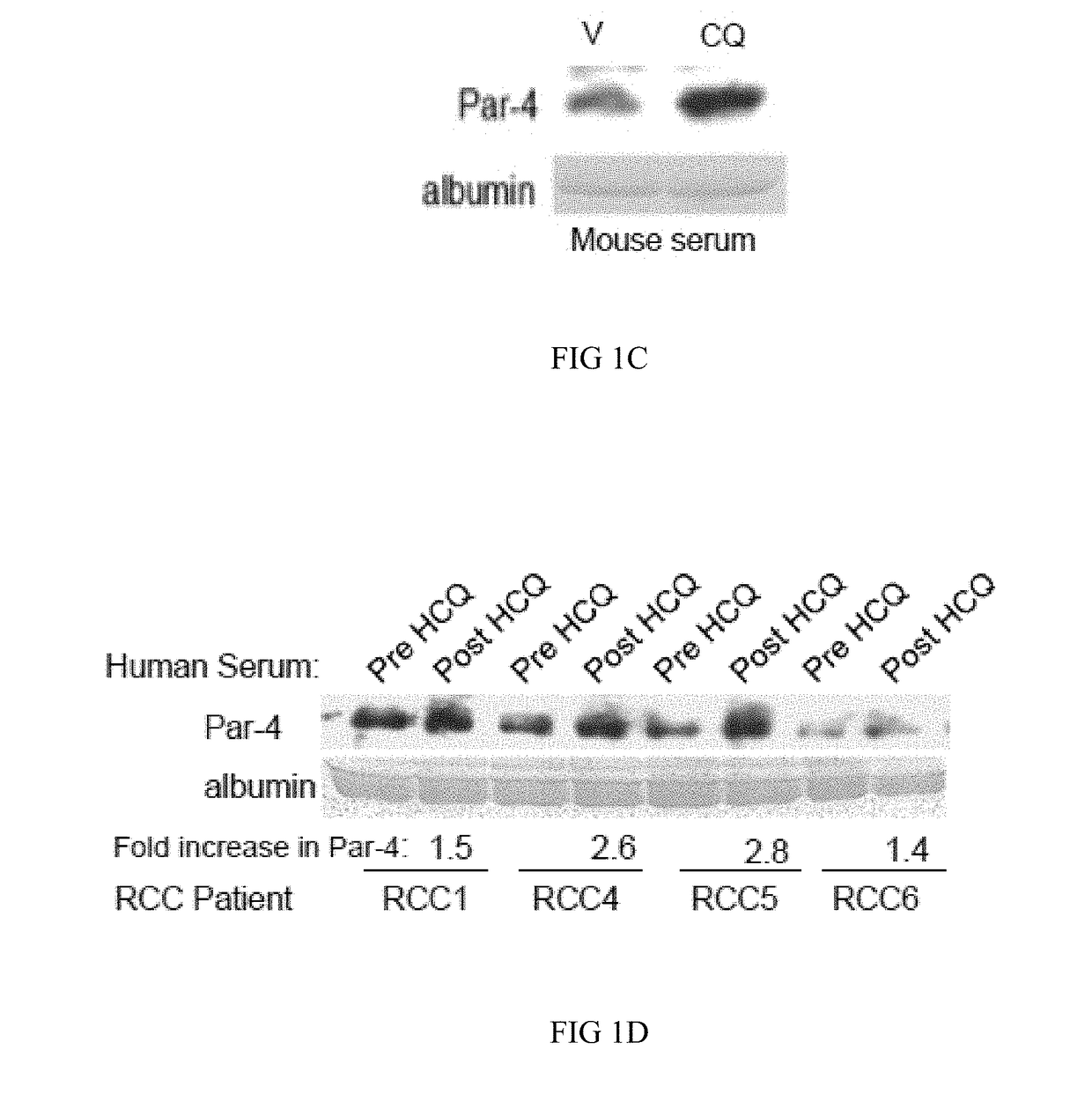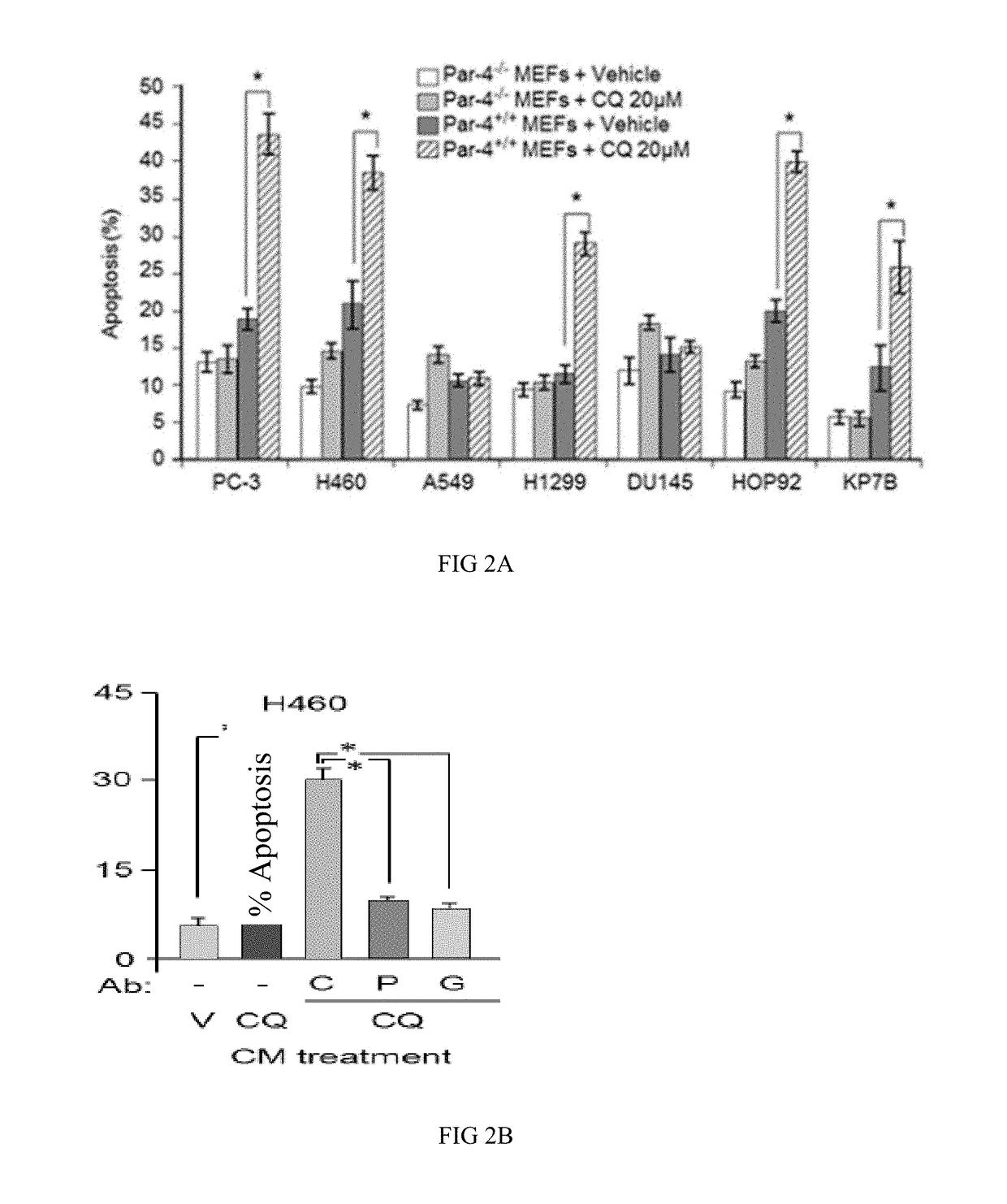Chloroquine Induction of Par-4 and Treatment of Cancer
a par-4 and chloroquine technology, applied in the field of cancer treatment, can solve the problems of inhibiting metastatic lung tumors, and achieve the effects of inhibiting the proliferation and/or metastasis of cancer cells, and reducing the risk of metastatic lung tumors
- Summary
- Abstract
- Description
- Claims
- Application Information
AI Technical Summary
Benefits of technology
Problems solved by technology
Method used
Image
Examples
example 1
[0079]The Results Presented Herein Demonstrate that Chloroquine Induces Secretion of Par-4 from Normal Cells.
[0080]Various normal mouse or human cell lines, mouse embryonic fibroblasts (MEFs, early passage 4 or 5), human primary prostate fibroblast cells (PrSC), human bronchial epithelial cells (HBEC), human primary prostate epithelial cells (PrEC), human lung embryonic fibroblasts (HEL), human prostate cancer cell lines, androgen-dependent LNCaP cells, and androgen-independent (castration-resistant) C4-2B, DU145 and PC-3 cells and human lung cancer cell lines H460 and A549 were treated with 1, 10, 20, 25, 50 or 100 μM of chloroquine diphosphate (CQ) or with a vehicle (V) control for 24 h.
[0081]The conditioned medium (CM), as well as the whole-cell lysates were subjected to Western blot analysis with the antibodies specific for Par-4, Collagen (Col1A1), albumin, or actin. Col1A1 served as a loading control for protein secretion, as it is generally unchanged in response to the treatm...
example 2
[0085]The results presented herein demonstrate CQ-inducible Par-4 secretion in CM of normal cells causes apoptosis in cancer cell cultures. Furthermore, the results demonstrate that the serum from a renal cell carcinoma patient who showed ˜3-fold induction of Par-4 following HCQ treatment also induces ex vivo apoptosis of various normal and cancer cells.
[0086]Briefly, MEFs from Par-4+ / + or Par-4+ / + mice were treated with vehicle (v) or CQ (20 μM) for 24 h, and their CM was transferred to normal (HEL) or p53-wild type lung cancer cells (H460 and A549), p53-deficient cancer lung cancer cells (HOP92 and H1299), and p53-deficient prostate cancer cells (PC-3 and DU145). After 24 h, the cells were subjected to immunocytochemistry (ICC) for active caspase-3 and apoptotic cells were scored under a fluorescent microscope. The results are depicted in FIGS. 2 A-F. An asterisk (*) indicates statistical significance (P<0.001) by the Student's t-test.
[0087]Prostate cancer cells PC-3, and lung can...
example 3
[0092]The results presented herein demonstrate that CQ induces tumor growth inhibition by a Par-4-dependent mechanism. The results also demonstrate that Par-4 in serum from CQ-treated mice induces ex vivo apoptosis in LLC1 cells.
[0093]Aliquots of culture media (CM) from Par-4− / − or Par-4+ / + MEFs treated with CQ (20 μM) or vehicle (v) were incubated with LLC1 cells for 24 h, and the cells were scored for apoptosis. Moreover, aliquots of CM from wild type MEFs treated with CQ or vehicle were incubated with control (C) antibody (Ab), Par-4 (P) Ab or GRP78 (G) Ab and then transferred to H460 cells. After 24 h, the cells were scored for apoptosis. * P+ / + MEFs but not from Par-4− / − MEFs treated with CQ induced apoptosis of LLC1 cells and this apoptotic activity in the CM was inhibited by the Par-4 (P) Ab or GRP78 (G) Ab (FIG. 3A).
[0094]In a model of tumor cell metastasis, LLC1 cells were injected intravenously into Par-4+ / + (wild type) or Par-4− / − mice, and then CQ (25 mg / kg body weight) ...
PUM
| Property | Measurement | Unit |
|---|---|---|
| volume | aaaaa | aaaaa |
| resistance | aaaaa | aaaaa |
| weight | aaaaa | aaaaa |
Abstract
Description
Claims
Application Information
 Login to View More
Login to View More - R&D
- Intellectual Property
- Life Sciences
- Materials
- Tech Scout
- Unparalleled Data Quality
- Higher Quality Content
- 60% Fewer Hallucinations
Browse by: Latest US Patents, China's latest patents, Technical Efficacy Thesaurus, Application Domain, Technology Topic, Popular Technical Reports.
© 2025 PatSnap. All rights reserved.Legal|Privacy policy|Modern Slavery Act Transparency Statement|Sitemap|About US| Contact US: help@patsnap.com



